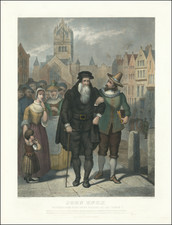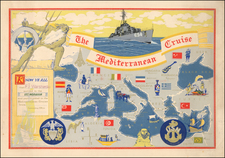A magnificent series of Old Master prints depicting the 'Seven Planets', after drawing by Maertin de Vos, and engraved by Gregor Fentzel.
This extremely rare and masterfully executed set of celestial engravings depicts the 'Seven Planets: Sol (the Sun), Luna (the Moon), Mercurius (Mercury), Venus, Mars, Jupiter and Saturn (note that the planet Earth was never included in the set, and the sun and the Moon are not technically planets, while Neptune and Pluto had not yet been discovered when the prints were made). One of the great achievements of the Flemish Old Masters was their ability to bring new life and beauty to ancient Classical subjects. In composing these evocative images, Maertin de Vos showed each planet to be personified by its own Classical god, amidst a vibrant pageant of allegory, accompanied by the appropriate Zodiacal signs. In this edition, De Vos's evocative drawings were engraved by Gregor Fentzel and published in Nuremburg around 1650. Each of the prints features De Vos's hallmark 'M de Vos figur'.
The seven engravings are described in the order in which they appear in the images above (top left to right):
Sol is shown to be riding on a chariot drawn by four horses in the clouds, while various ceremonies take place below, including the crowning of a king, the anointing of a pope, triumphal procession through arch. The zodiac sign of Leo appears in an oval in the top center.
Luna, with is represented by the Goddess Diana, carries a bow and quiver of arrows and rides in a chariot drawn by two nymphs on clouds in the sky, above an extensive marine landscape with ships and fishing vessels below. The zodiac sign of Cancer is located within an oval in the top center.
Mercury, represented by the God of Travel, is seen holding a caduceus and riding in a chariot drawn by two birds, while below lies a broad landscape with a harbor featuring bountiful goods. The zodiac signs of Gemini and Virgo are located in ovals in the top corners.
Venus, represented by the Goddess of Love, is seen riding in a chariot drawn by two Peacocks, while below lies a grand landscape populated by prosperous towns. The zodiac signs of Libra and Taurus are located within ovals in the top corners.
Mars, represented by the God of War, is shown wearing armor and riding in a chariot drawn by two horses upon a road of clouds, while below is an extensive landscape featuring grand edifices, highwaymen and soldiers. The zodiac signs of Capricorn and Scorpio are located within ovals in the top corners.
Jupiter is shown holding thunderbolts and riding in a chariot drawn by two eagles upon clouds, while below lies a broad extensive landscape with a myriad of buildings and small rocky islands. The zodiac signs of Sagittarius and Pisces are placed in ovals in the top corners.
Saturn is shown holding a scythe and sitting in a chariot drawn by two dragons, while below is a landscape inhabited with various figures engaged in industry, including mining. The zodiac signs of Aries and Aquarius appear within ovals in the top corners
The series is based on the original artworks of the painter and draftsman Marten de Vos (1532-1603), one of the leading figures of Flemish Renaissance art. While based in Antwerp, De Vos travelled to Italy where he mastered the contemporary mannerist style. De Vos was also highly influenced by the 'colore' of Venetian painting, and is thought that he may have worked as an apprentice to the Serene Republic's great master, Jacopo Tintoretto. Following the destruction of Catholic imagery by Protestants in Antwerp in 1566, De Vos was one of the main artists responsible redecorating the city's churches. Some of greatest masterpieces include the paintings St. Luke Painting the Virgin (1602) in Antwerp's 'Schilderkamer' (painter's room) and the Marriage at Cana (1597), painted for the wine merchants guild. De Vos was also a noted humanist thinker, and his work had enduring legacy, being a key influence for the legendary Peter Paul Rubens (1577-1640).
The present set represents the second edition of De Vos's planets. The first edition was engraved by Jan Sadeler I (1550-1600) and published in Antwerp around 1585. The entire set was later re-engraved to a very high standard by Gregor Fentzel, and published by P. Fürst in Nuremburg around 1650, and the present set is of this edition. The Sadeler and Fentzel edition can be distinguished by the respective appearance of each engraver's names on some of the prints, such that in the case of the Fentzel editions, one finds the appearance of 'G. Fentzel sculp' or 'Gregorius Fentzel sculp'.
The condition of the present set is very fine, However, while it includes all seven 'planets', it lacks the title engraving, which features the title: Planetarum Effectus et eorum in signis Zodiaci… De Vos's set of the Planets is scarce in all editions, especially ones featuring all seven planets.









![(Rare Czech Edition!) [Asia Secunda Pars Terrae in Forma Pegasi] [Asia in the Form of Pegasus]](https://storage.googleapis.com/raremaps/img/small/95830.jpg)
![[Autographs of British Admirals During the American Revolution & War of 1812]](https://storage.googleapis.com/raremaps/img/small/69274.jpg)
![Theoria Veneris Et Mercurii [Exceptional original hand-color with highlights in gold]](https://storage.googleapis.com/raremaps/img/small/81865.jpg)

![Globus Coelestis [Fig: 2]](https://storage.googleapis.com/raremaps/img/small/79601.jpg)
